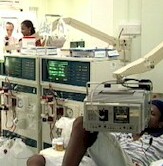
SATURDAY, May 4 (HealthDay News) — The death risk for American children and teens undergoing dialysis for kidney failure has dropped significantly in recent decades, a new study finds.
Researchers analyzed data from more than 23,000 patients younger than age 21 who began dialysis between 1990 and 2010. During that time, there was a progressive decrease in the rates of deaths from all causes and from heart- and infection-related causes.
“Numerous factors may have contributed to the observed reductions in [death] risk over time,” said Dr. Mark Mitsnefes, of Cincinnati Children’s Hospital Medical Center, and colleagues. “Improved pre-dialysis care, advances in dialysis technology and greater experience of clinicians may each have played a role.”
Further research is needed to pinpoint the specific reasons for the decreasing death rate among youngsters undergoing dialysis, they added.
The study was published online May 4 in the Journal of the American Medical Association to coincide with a scheduled presentation at the Pediatric Academic Societies annual meeting in Washington, D.C.
Kidney failure patients have a significantly shortened life expectancy and the loss of potential years of life is greatest among children and teens. Kidney transplants offer these youngsters the best opportunity for survival, growth and development. But 75 percent of these patients require dialysis while waiting for a kidney transplant, the study authors noted.
Dialysis is a lifesaving treatment for children and teens with kidney failure who are waiting for a kidney transplant, but the death rate among youngsters on dialysis is at least 30 times higher than for those in the general population. The risk is highest among very young children.
More information
The U.S. National Institute of Diabetes and Digestive and Kidney Diseases outlines treatment options for children with kidney failure.

